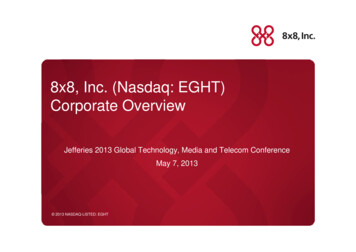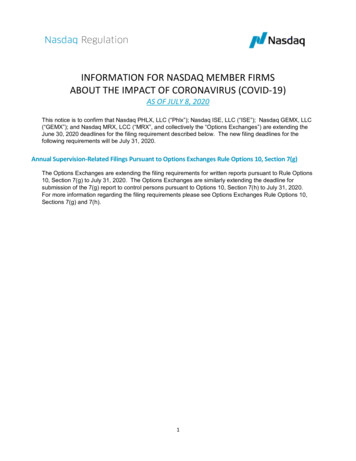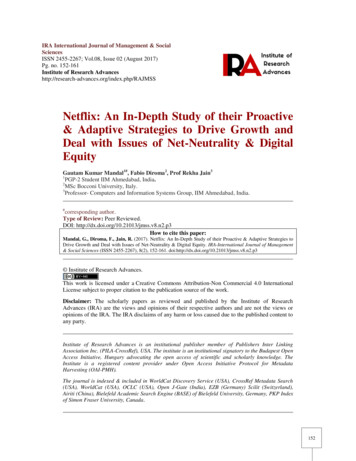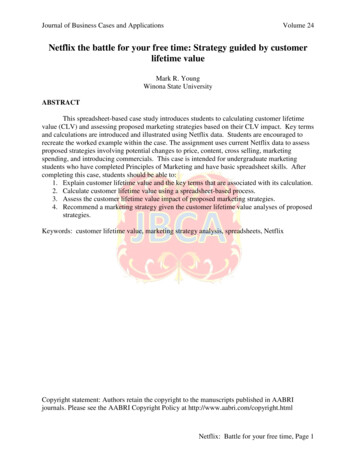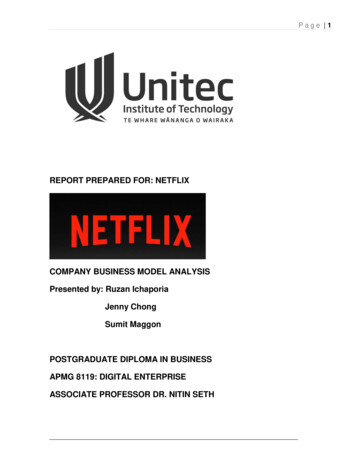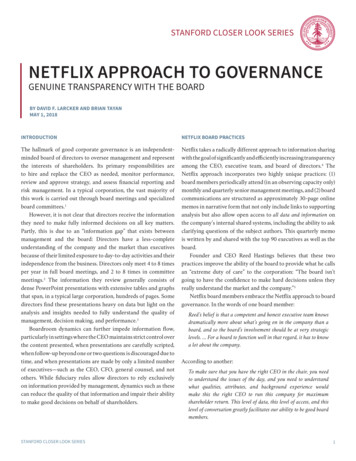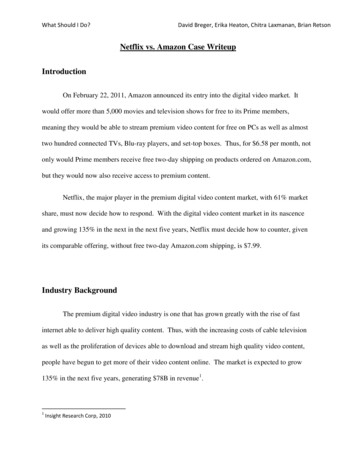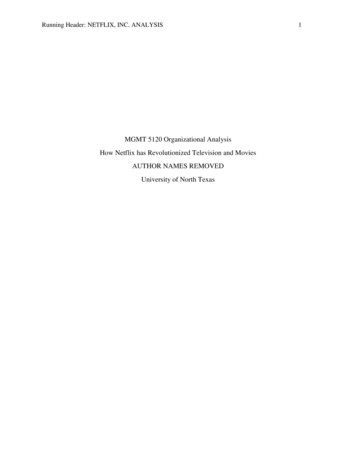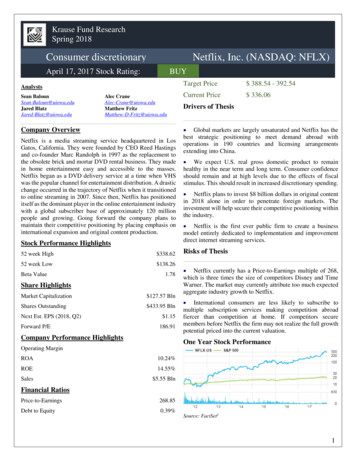
Transcription
BUYKrause Fund ResearchSpring 2018Consumer discretionaryNetflix, Inc. (NASDAQ: NFLX)April 17, 2017 Stock Rating:BUYCurrent PriceAnalystsSean BalounSean-Baloun@uiowa.eduJared BlatzJared-Blatz@uiowa.eduAlec CraneAlec-Crane@uiowa.eduMatthew FritzMatthew-D-Fritz@uiowa.eduCompany OverviewNetflix is a media streaming service headquartered in LosGatos, California. They were founded by CEO Reed Hastingsand co-founder Marc Randolph in 1997 as the replacement tothe obsolete brick and mortar DVD rental business. They madein home entertainment easy and accessible to the masses.Netflix began as a DVD delivery service at a time when VHSwas the popular channel for entertainment distribution. A drasticchange occurred in the trajectory of Netflix when it transitionedto online streaming in 2007. Since then, Netflix has positioneditself as the dominant player in the online entertainment industrywith a global subscriber base of approximately 120 millionpeople and growing. Going forward the company plans tomaintain their competitive positioning by placing emphasis oninternational expansion and original content production.Stock Performance Highlights52 week High 338.6252 week Low 138.26Beta Value1.78Share HighlightsMarket Capitalization 127.57 BlnShares Outstanding 433.95 BlnNext Est. EPS (2018, Q2)Forward P/E 1.15186.91Company Performance Highlights 332Target Price 388.54 - 392.54Current Price 336.06Drivers of Thesis Global markets are largely unsaturated and Netflix has thebest strategic positioning to meet demand abroad withoperations in 190 countries and licensing arrangementsextending into China. We expect U.S. real gross domestic product to remainhealthy in the near term and long term. Consumer confidenceshould remain and at high levels due to the effects of fiscalstimulus. This should result in increased discretionary spending. Netflix plans to invest 8 billion dollars in original contentin 2018 alone in order to penetrate foreign markets. Theinvestment will help secure their competitive positioning withinthe industry. Netflix is the first ever public firm to create a businessmodel entirely dedicated to implementation and improvementdirect internet streaming services.Risks of Thesis Netflix currently has a Price-to-Earnings multiple of 268,which is three times the size of competitors Disney and TimeWarner. The market may currently attribute too much expectedaggregate industry growth to Netflix. International consumers are less likely to subscribe tomultiple subscription services making competition abroadfiercer than competition at home. If competitors securemembers before Netflix the firm may not realize the full growthpotential priced into the current valuation.One Year Stock PerformanceOperating MarginROA10.24%ROE14.55%Sales 5.55 BlnFinancial RatiosPrice-to-Earnings268.85Debt to Equity0.39%Source: FactSet21
Macroeconomic OutlookReal Gross Domestic ProductReal gross domestic product is the value of all finished goodsand services produced in a country over a period of time. Thismetric is often used to indicate the health of the economy. RealGDP increased at a CAGR of 3.16% and 2.89% in quarters threeand four of 2017.3 These values are relatively strong comparedto the average 10 year CAGR of 2.11%.2 As reflected in thegraph below, consumer spending currently accounts for roughly70% of real GDP. We expect consumption as a percentage ofGDP to remain at current levels for the foreseeable future.Because of this, we view changes in real GDP as the strongestindication of the direction of the consumer discretionary sector.Though declining growth in real GDP may negatively affect theconsumer discretionary sector as a whole, the subscription basedbusiness may be an exception. People have the tendency to holdonto subscription services in during economic downturns.Investment and ProductionThe Institute for Supply Management (ISM) comes out with areport each month detailing the month to month activity of theprivate sector economy.11 They create the PMI index whichshows what the demand for producion is in America by trackingvariables such as output and new orders. Demand formanufacturing increases when companies and consumers havemore money to spend on inputs and household items. Typically,a reading grater than 50 signals increased economic activity.The PMI hit a 5 year high of 60.8 in Febrauary 20185. Currentlevels of 59.3 remain above last years average of 57.5. 5PMI INDEXSource: ISM 5With new orders, production, and employment still growing,, weexpect levels to remain elevated at 58-60 throughout 2018. Theoptimism surrounding ISM is a good sign for business. Moremoney will travel throughout the economy in the coming yearand in the pockets of households.UnemploymentSource: FRED 3ForecastThe FOMC’s median forecast for 2018 real GDP is 2.7%,followed by a gradual decrease to 1.8% in the long run.4 Weview this forecast as overly pessimistic. As a result of increasedinvestment, low unemployment, and projected wage gains, weexpect real GDP to be 3% in 2018. We assume economic growthwill gradually decrease over the next 3 years, reaching 2.0% by2021.Our optimism is primarily driven from the stimulus we expectcorporate and personal tax cuts to provide. In January 2018, thecurrent administration enacted a tax overhaul reducing thecorporate tax rate from 35% to 21% and reducing personalincome taxes across the board. We expect the lower tax rateswill increase investment in the U.S. and supply households withmore discretionary income. In the long term we view interestrates and a gradual decrease in consumer spending as theprimary contributors to the decline in real GDP growth.The unemployment rate is the percentage of unemployedpersons in the labor force. A healthy rate of naturalunemployment is considered to be 5%.43 Since the finiancialcrisis the unemploymenr rate has decreased from 10% in 2010,to a current rate of 4.1%.6 The economy has been gainingmomentum and we view recent tax cuts will be a positivestimulus to an already thriving business environment.Companies such as Apple have promised to create 20,000new jobs,7 and foreign companies are increasing greenfieldinvestments in the United States.8 In consideration of theexpected increase of economic activity in 2018 we expectunemployment to hit 4.0% this year. As unemploymentdecreases further there will be an increased number of peoplereceiving a stable income and thus more people buyingservices such as Netflix.Wage GainsContrary to the positive rhetoric regarding unemploymentlevels, the downward pressures on wages from the recession of‘09 have remained throughout the recovery. In quarter 4 of2010, year over year nominal wage growth was 2.5%. In quarter2
4 of 2017 it was 2.4%.9 These growth rates are small relative tothe 4% we were experiening before 2008.8 When workers arenot getting large increases in pay they are not encouraged toincrease their spending. However, we have just begun to seesome upward pressure on wages and thus increased space fordiscretionary spending. This can be seee in the graph below.Personal income has increased for the fourth straight month at0.4%3.0.600%Personal Income ource: FRED 3Given the increase in investment, tight labor market, and currentphase of the economic cycle, we expect monthy personalincome growth to be in the range of 0.4% and 0.6% throughout2018. The stability and growth in wages will give consumersconfidence in their spending habits and find themselves morewilling to use money for discretionary spening.Consumer SentimentConsumer confidence is a survey index that measures the publicopinion on future business conditions, income growth, and jobavailability.11 The consumer confidence index is a key indicatorfor the health of the consumer discretionary sector. With a moreconfident consumer comes a greater willingness to spend.Historically, consumer confidence increases duringexpansionary periods. Consumer confidence hit an 18 year highof 101.05 in February, 2018 followed by a slight decrease to97.8 in March.11 We attribute the decrease of confidence touncertainty surrounding trade negotiations with China. Thethreat of a trade war would mean increase costs for business andhigher consumer prices. However, recently Chinese PresidentXi Jinping has announced plans to ease capital controls ondirectforeign investment.42 We expect the consumer confidenceindex to rise in the near term and remain at approximately 101.0throughout 2018.Source:: OECD12Capital Markets OutlookA relatively new occurrence within the markets is the rise involatility. A 20% drop in the VIX shook the markets onFebruary 6, 2018 and since then stocks seen a greater level ofvolatility. We feel volatility will remain a factor as long as thecurrent administration retains its protectionalist position oneconomic development causing disruption to a historicallystable domestic balance of payments. Furthermore, we expectuncertainty surounding the expected probability of interst rateincreases to facor into market volatility. As interest rates rise sowill the attraction for fixed-income instruments. We expectlarge sums of liquidity to transfer from equities to fixed incomesecurities as interest rates increase.However, we viewIndustrythis volatilityAnalysisas normalized.Industry SynopsisGICS classifies Netflix as an Internet & Direct Marketing Retailfirm. Online media streaming is one of the features of thecontinuously evolving information technology era that we are apart of. Streaming began with YouTube in 2005. The streamingspace has evolved rapidly with Netflix being the first companyto stream television shows and movies online in 2007.Increasingly, convenience and immediate satisfaction isbecoming a demand from consumers. The internet and directmarketing retail industry is catering to that norm. We have seenan exponential adoption of online streaming services due to theiraccommodative and innovative nature. For example, viewershipis enhanced with the unison of more than one device.Consumers can quickly stream content through content throughPC’s, televisions, and smart phones as long as they areconnected to the internet. User experience is another feature theindustry focuses on as a way to disrupt the entertainmentindustry. Unlike traditional television, online media streamingcompanies utilize the data they have on you to provide you withan optimal set of choices when deciding what to watch.Accessing entertainment through the internet was a trend that isnow becoming a norm.3
Internet TrendRevenue StreamsMore and more consumer are cutting the cord and opting insteadto for direct internet streaming. The shift to the internet is atremendous threat to traditional television networks. The belowtells the story of the customer gains and losses for cablecompanies in comparison to gains for online streamingcompanies such as Netflix, Hulu, and Amazon Prime.The two primary streams of revenue are subscription paymentsand advertising. The subscription based model is becomingincreasingly popular. Usually, companies within the industrystructure their services in such a way that consumers pay a fixedfee at various price levels based off how much they want to getout of the service. For example, Netflix offers a base rate thatallows you to lets you stream TV shows and movies fromNetflix on one device at a time in standard definition whereasits gold membership gives you access to lets you stream TVshows and movies from Netflix on four devices at the same timeand in high definition. Companies can also chose to receiverevenue from streaming advertisements. 2017 was the first yearthat digital advertising spending was higher than traditional TV.This reflects the increase in popularity of the industry and weexpect companies that show ads such as Hulu to leverage thistrend.YearPay TV Gains/LossesInternet 2,700,0002017-1,495,0002,100,000Source: Leichtman Research Group 13However, traditional television still has an established positionin the U.S. This can be attributed to an increasing hesitance ofolder generations to cut the cord. The below representsconsumption habits by age.50.0%Distribution of advertisingspending in the U.S40.0%30.0%20.0%10.0%0.0%201020112012 2013Digital2014 2015TV20162017Source: Statista9Source: Statista14Approximately 50% of adult’s age 18-44 claim to use streamingservices more than they do traditional TV. That numberdecreases to the 13% – 27% range for adults ages 45 and older.We expect the internet streaming to be the primary source ofentertainment for adults age 18 – 4, increasing the percentage ofthose who use streaming more than traditional to 90% by 2025.We feel adults age 45 – 64 will be late adopters and increasetheir willingness to stream more than watch traditional to 50%by 2025. Lastly, baby boomers are traditional and have theirhabits established by now. We expect a very slow shift of thisdemographic towards internet streaming.A relatively new revenue stream is original content productionand licensing. The move for Netflix to license out Narcos toUnivision in 2017 was the first of its kind. Additionally, Netflixintends to utilize this strategy as a means to access the Chinesemarket.30 We expect this large growth of this revenue stream forthe industry moving forward especially as a means to access theChinese marketplace.Competitive LandscapeThrough first mover advantage, Netflix has a strong footholdwithin the industry. As online streaming has grown inpopularity, the level of competition has increased. Below is agraph showing the popularity of the various players in the mediastreaming industry that have entered the market since 2007.Given performance, size, and scope; we view Amazon and Huluas Netflix’s primary competitors. HBO GO requires a cablesubscription and is therefore not relevant to our industryanalysis.4
plays a large role in dif
17.04.2017 · Netflix is a media streaming service headquartered in Los Gatos, California. They were founded by CEO Reed Hastings and co-founder Marc Randolph in 1997 as the replacement to the obsolete brick and mortar DVD rental business. They made in home entertainment easy and accessible to the masses. Netflix began as a DVD delivery service at a time when VHS was the popular channel

